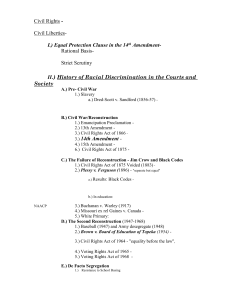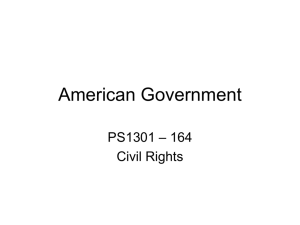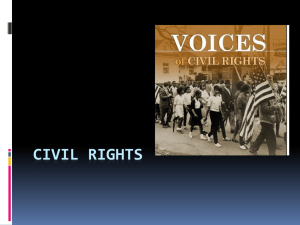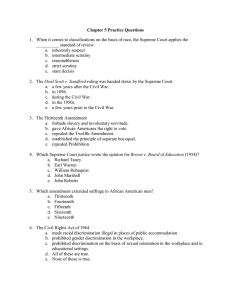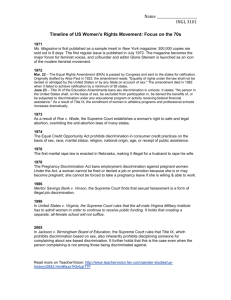Equal Rights: Struggling Toward Fairness
advertisement
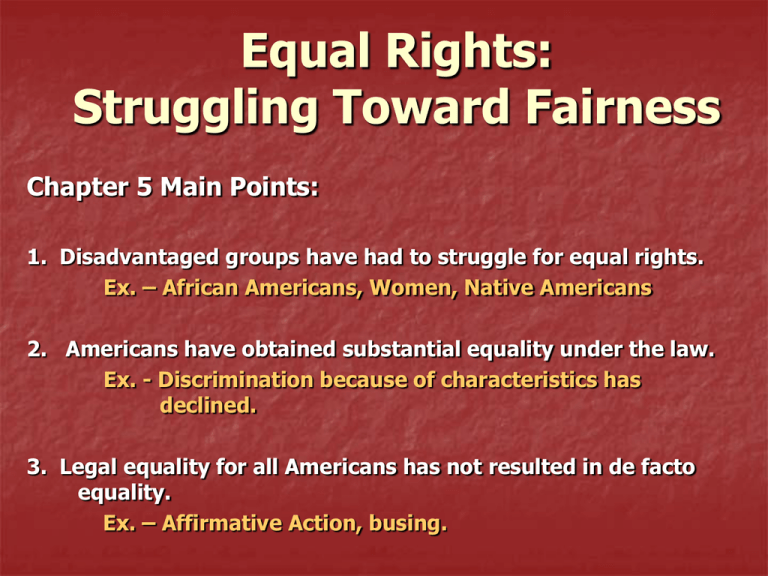
Equal Rights: Struggling Toward Fairness Chapter 5 Main Points: 1. Disadvantaged groups have had to struggle for equal rights. Ex. – African Americans, Women, Native Americans 2. Americans have obtained substantial equality under the law. Ex. - Discrimination because of characteristics has declined. 3. Legal equality for all Americans has not resulted in de facto equality. Ex. – Affirmative Action, busing. In 1955 Rosa Parks was arrested for disobeying a segregation law in Montgomery, Alabama, that required her to give up her seat on a bus to a white person. Women’s Rights Movement During the late 1960s and early 1970s, women began to work for equal rights. They wanted to end discrimination against women at home and work. To accomplish this, women began taking part in marches, working for the passage of the Equal Rights Amendment (ERA), and generally speaking out against inequality. The Indian Reorganization Act, passed in 1934 during the Franklin Roosevelt administration, attempted to give Native Americans increased control over their lives. The history of America shows that disadvantaged groups have rarely achieved a greater measure of justice without a struggle. Their gains have nearly always followed intense and sustained political action that forced entrenched interest to relinquish or share their privileged status. Thomas Jefferson 1. People were of equal moral worth. 2. People deserve equal treatment under the law. 3. Only free men deserved legal equality. African Americans Invoice for Slave Purchases This invoice, dated 1835, lists the names and prices of slaves purchased by an individual slave owner. By 1800, eight years before the abolition of slave importation, some 930,000 slaves resided in the United States, of whom 36,000 lived in the northern states. The majority of slaves (more than 9.5 million) were forcibly shipped to the agricultural plantations of Central and South America and the Caribbean. Civil War Ends Slavery, During the American Civil War, the Battle of Gettysburg began on July 1, 1863, when a Confederate brigade searching for a badly needed supply of shoes in the small town of Gettysburg, Pennsylvania, ran into Union cavalry. After the three days of battle were over, Union forces claimed victory, although both sides suffered heavy casualties. This photograph of the battlefield shows the dead soldiers. Union Casualties at Gettysburg But not racism. “Unequal Justice” 1896 – Plessy v. Ferguson – “Separate but Equal” Black children were forced into separate schools that had few teachers and inadequate libraries; they were given worn out text books that had been used previously in white schools. 1930’s - The Supreme Court began to acknowledge the plight of the underprivileged. 1st Ruling – The Court said that if no separate facilities existed for African Americans, they must be allowed to use those reserved for whites. Oklahoma had no separate law school for blacks when it was ordered to admit Ada Sipuel in 1949. It created one in a roped-off corridor of the state capitol building while the white students continued to meet at the University of Oklahoma’s law school in Norman, twenty miles away. How did Black Americans challenge discriminatory policies? Legal Action Brown v. Board of Education of Topeka (1954) The Supreme Court of the United States unanimously declared that it was unconstitutional to create separate schools for children on the basis of race. The Brown ruling ranks as one of the most important Supreme Court decisions of the 20th century. At the time of the decision, 17 southern states and the District of Columbia required that all public schools be racially segregated. Why? Because it violated the equal protection clause of the 14th Amendment The Black Civil Rights Movement Birmingham police commissioner, Eugene “Bull” Connor, would meet protesters with violence. In May 1963 King and his SCLC staff escalated antisegregation marches in Birmingham by encouraging teenagers and school children to join. Hundreds of singing children filled the streets of downtown Birmingham, angering Connor, who sent police officers with attack dogs and firefighters with high-pressure water hoses against the marchers. Scenes of young protesters being attacked by dogs and pinned against buildings by torrents of water from fire hoses were shown in newspapers and on televisions around the world. The Black Civil Rights Movement King and other black leaders organized the 1963 March on Washington, a massive protest in Washington, D.C., for jobs and civil rights. On August 28, 1963, King delivered a stirring address to an audience of more than 200,000 civil rights supporters. His “I Have a Dream” speech expressed the hopes of the civil rights movement in oratory as moving as any in American history. Civil Rights Legislation 1964 – The Civil Rights Act Provided African Americans and other minorities with equal access to public facilities and job discrimination. 1965 - The Voting Rights Act Ended racial barriers to voting. Susan B. Anthony Susan Brownell Anthony, along with fellow reformer Elizabeth Cady Stanton, led the woman-suffrage movement in the United States during the 19th century. Both activists believed that women could not effectively promote social reform without the right to vote. Anthony devoted 50 years of her life to the suffrage movement; she died in 1906, 14 years before the 19th Amendment to the Constitution of the United States granted women the right to vote. In 1979 she became the first woman to be pictured on circulating United States currency, the one-dollar coin. Women's Legal and Political Gains 1920 – 19th Amendment Gave women the right to vote. 1963 – Equal Pay Act 1972 – Title IX of the Education Amendment Prohibits sexual discrimination in education. 1973 – Congress approves the ERA The ERA failed ratification by three states. (Three-fourths majority required for ratification) Gender Gap – the tendency of women and men to differ in their political attitudes and voting preferences. Government statistics indicate that more than two thirds of employment-aged women work outside the home compared with only one in eight a halfcentury ago. 1993 – Congress passed the Family and Medical Leave Act – provides twelve weeks of unpaid leave for employees, male or female, to care for a new baby or a seriously ill family member. Women in the U.S. Labor Force The participation of women in the labor force expanded dramatically during the 20th century, with the greatest increase occurring among married women. In 1900 less than 10 percent of married women held jobs outside the home. In 1998 about 61 percent held jobs in the work place. Glass Ceiling – The invisible barrier to advancement that talented women encounter after they have reached the middle-management level. Comparable Worth – Proposal to pay women equally for work that is of similar difficulty and that requires similar training. The average pay for full-time female employees is only about three-fourths that of full-time male employees. Native Americans By 1900 – Indian population had dropped from 10 million to less than 1 million. Reservations are ruled by the treaties signed when they were established. State governments have no direct authority over them. The federal government has only limited authority. Current U.S. policy is to promote selfgovernment and self-sufficiency while preserving the Native American culture. Native Americans were not even official citizens of the United States until passage of an act of Congress in 1924. Hispanic Americans The fastest-growing minority group in the United States in that of Hispanic Americans. With more than 35 million Hispanics now living in the U.S. they have replace African Americans as the largest racial or ethnic minority group. Legal and Political Action Proposition 187 – Aimed to cut off public services to illegal immigrants. State-funded food stamps, welfare, medical care except for life-threatening situations, no longer eligible for public schooling at ay level. ** Most of the provisions of Proposition 187 were declared unconstitutional. ** 10 Million illegal workers in the U.S. – mostly Hispanic. Equality Under The Law Equal-Protection Clause – Forbids any state from denying equal protection of the laws to any individual within its jurisdiction. Reasonable-basis test – The courts require government only to show that a particular law has a sound basis. (21 year-olds can drink alcohol / 20 year-olds cannot) Reasonable because alcohol related accidents decrease with older drivers. ** Does not apply to racial or ethnic classifications. Strict-scrutiny test - Any law that treats people differently because of race or ethnicity are considered unconstitutional. Intermediate Scrutiny Test United States v. Virginia (1996) (VMI) In June 1996 the Supreme Court of the United States ordered the Virginia Military Institute(157 year-old state supported school) to admit women. The school complied with the order in the fall of 1997 by admitting 32 women to its incoming class of 460 students. In August 1995, following a two-anda-half-year legal battle, Shannon Faulkner became the first full-time female student at The Citadel. The 14th Amendment applies only to action by government. It does not prohibit discrimination by private parties. As a result, for a long period of time in the nation’s history, owners could legally bar black people from restaurants, hotels, and other accommodations. Employers could freely discriminate in their job practices. Since the 1960’s, firms have had much less freedom to discriminate on the basis of race, sex, ethnicity, or religion. Civil Rights Act of 1964 Entitles persons to equal access to restaurants, hotels, bars, theaters, gas stations – all general public services. The legislation also bars discrimination in the hiring, promotion, and wages of medium to large sized firms. The Civil Rights Act of 1964 has nearly eliminated the most overt forms of discrimination in the area of public accommodations. The Voting Rights Act of 1965 Forbids discrimination in voting and registration. It also eliminated the practice of having to pass a literacy test to vote. Equality of Result Civil Rights problems involve deeply rooted conditions, habits, and prejudices and affect whole categories of people. For these reasons, a new civil rights policy rarely produces a sudden and dramatic change in society. De Facto Discrimination – Discrimination that is a consequence of social, economic, and cultural biases and conditions. De Jure Discrimination – Discrimination on the basis of race, sex, religion, ethnicity, and the like that results from a law. Equality of Result Aim of policies intended to reduce or eliminate de facto discrimination. My Belief – The governments responsibility extends no further than the removal of legal barriers to equality. (Personal Liberties) Given that position, I believe that some policies intended to achieve equality of result, such as affirmative action and busing, are inherently wrong. Affirmative Action: Workplace Integration There is a difficulty in converting newly acquired legal rights into everyday realities. The Civil Rights Act of 1964 prohibited discrimination in the workplace, women and minorities didn’t suddenly obtain jobs for which they were qualified. The Civil Rights Act did not require employers to prove that their hiring practices were not discriminatory. Instead, the burden of proof was on the woman or minority group member who had been denied a particular job. A broader remedy was required. Affirmative Action ► Programs designed to ensure that women, minorities, and other traditionally disadvantaged groups have full access and equal opportunities in employment, education, and other areas of life. ** Places the burden of proof on the providers of opportunities, who, to some extent, must be able to demonstrate that any disproportionate granting of opportunities to white males is not he result of some discriminatory practices. Most Americans support affirmative action when it comes to programs that will give women and minorities an equal chance at opportunities but oppose it when it comes to programs that will give them preferential treatment and lead to reverse discrimination. University of California Regents v. Bakke (1978) Alan Bakke, a white male, had been twice denied admission to a University of California Medical School, even though his admission scores were higher than those of several minority-group students who had been accepted. Bakke claimed the school had a quota system for minorities that discriminated against white males. The Supreme Court ruled in Bakke’s favor but did not invalidate affirmative action per se. Adarand v. Pena 1995 The Supreme Court examined a federal statute that reserved “not less than 10 percent” of funds provided for highway construction for small businesses owned by “socially and economically disadvantaged individuals.” The court’s majority opinion, written by Sandra Day O’Connor, overturned the statute and declared that even federal affirmative action programs are constitutional only when they are “narrowly tailored” to serve a “compelling government interest.” In other words, the government cannot issue general requirements (such as a quota of 10%) as a means of remedying past discrimination. Gratz v. Bollinger 2003 The Supreme Court stuck down the University of Michigan’s point system for undergraduate admission, which granted twenty points (out of total of one hundred and fifty possible points) to minority applicants. School Integration: Busing The 1954 Brown ruling mandated an end to forced segregation of public schools. Brown did not mandate that school integration take place. Ten years after Brown, less than 3% of black children were attending schools that were predominantly white. Swann v. Charlotte-Mecklenburg County Board of Education 1971 The Supreme Court ruled that the busing of children from one neighborhood to another was a permissible way for courts to compel the integration of public schools. Unlike Brown, which affected mainly the South, Swann also applied to northern communities in which African Americans and whites live apart as a result of economic and cultural differences.
